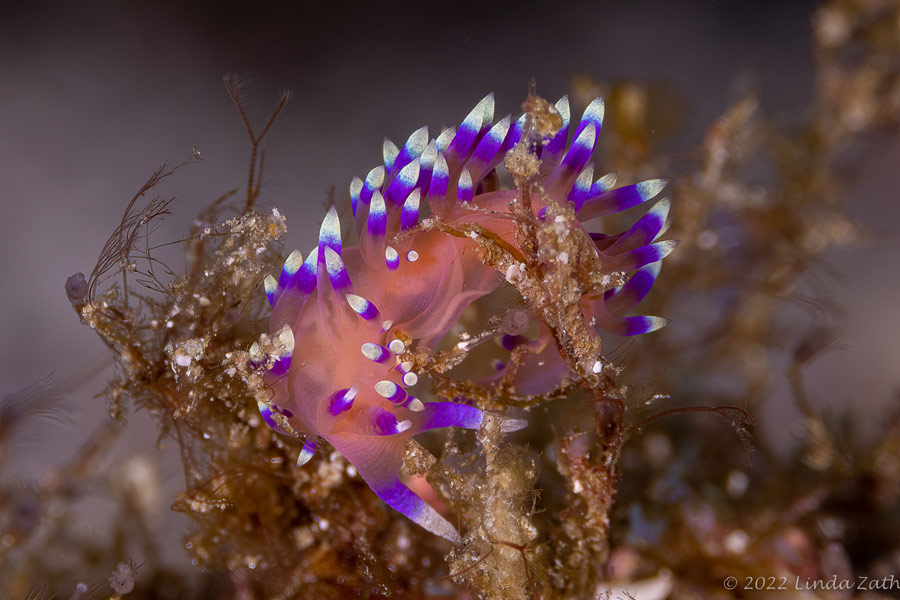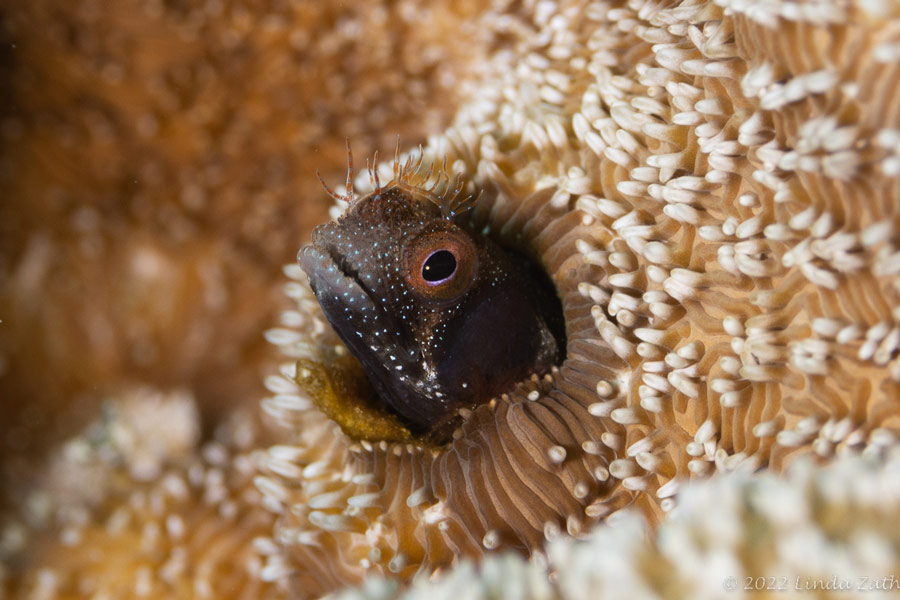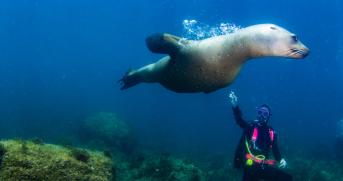Explore Baja, Sea of Cortez Trip Report
Bluewater Travel's Photo Workshop – Oct 22 to Nov 3, 2022
Words by Linda Zath & Michael Pizzi. Photos by Linda Zath, Michael Pizzi and guests
The Sea of Cortez lies between mainland Mexico and the peninsula of Baja California, dotted with mountainous islands that portray the rugged beauty of the Sonoran Desert. The peaks extend majestically up from the sea, especially as the sun rises out of the east to gently kiss the tops of the mountains. Enjoying this aspect of the Sea of Cortez from a liveaboard is heaven! However, for divers, the real treasures are hidden under the rich blue-green waters. The abundance of marine life and its diversity is what prompted Jaques Cousteau to call it “the world’s aquarium.” While this quote is often overused it doesn’t make it any less true, especially for divers. When asked “what is there to see?” the response - “the possibilities are endless.” From the tiniest of nudibranchs, porcupine fish, blennies, jacks, sergeant majors, angels, eels, sardine bait balls, sea lions, and whales. In the fall of 2022 eighteen divers had the opportunity to explore the depths of the Sea of Cortez as they boarded the Rocio Del Mar on the Bluewater Explore Baja trip.
This is one of the easiest liveaboards in regards to travel for Americans. Simply fly into Phoenix Arizona and a shuttle van takes you right to the Rocio Del Mar in a little over 4 hours, border crossing and snack stop included.
Our group gathered in the baggage area of the airport, waiting on the shuttle, as one by one the next diver joined the Explore Baja guests.
There were easy conversations about the upcoming days of diving and underwater photography sprinkled with the excitement to be sailing the 700 mile length of the Gulf of California. We all had a good laugh about how easy it was to spot divers/ underwater photographers – they’re the ones with large pieces of luggage. The shuttle arrived and off we went, headed south of the border to the Rocio Del Mar which was our home for the following two weeks.
Day 1: Puerto Penasco
The Rocio, as the crew affectionately call her, is a ship built for divers. The cabins are nicely designed with plenty of storage for personal items, each cabin has an ensuite bathroom, and the large dive deck has individual stations with a stow area for gear. The camera table is sizable and quickly filled up with a variety of camera gear including GoPro, Olympus, Canon, Nikon, and Sony.
Each photographer was keen to set up and test their gear before we got underway. The first evening was spent in port as the harbor master closed the harbor due to high winds. Everyone took the opportunity to double check gear and download last minute software as no cell service was expected for the majority of the trip.
Puerto Penasco Harbor. Photographed with Canon EOS R5 and Canon EF 24-105mm lens. F/8.0, 1/320, ISO 200 by Linda Zath
Day 2 & 3: Puerto Peñasco to Bahia De Los Ángeles
The next morning we left the harbor for a 12-hour transit to our first dive location, Bahia De Los Ángeles. The Explore Baja trip is a photography workshop and an extended trip like Explore Baja allows trip leaders and guests to become better acquainted to focus on each guests’ specific needs, allowing more 1:1 time. The transit day was filled with discussions on what the northern Sea of Cortez has to offer as well as details on how to photograph or video fast moving whale sharks in ambient light. Our dives at Punta Rincon and La Ventana provided plenty of macro opportunities with a variety of wrasse, blue spotted jawfish, rays and anemones. The whale shark snorkeling did not disappoint, there were many good encounters with the whale sharks of Bahia De Los Angeles and a few special encounters with a young, approximately 10’, juvenile whale shark. As we enjoyed dinner in the galley and discussed the day’s events Captain Julio made the overnight transit to San Pedro Martir.
(L) Whale Shark at Bahia de los Ángeles. Photo by Justin Knittel. // (M) Christmas Tree Worm (Spirobranchus giganteus) Photo By Steve Zimmerman. // (R) The Spotted Hawkfish (Cirrhitichthys oxycephalus) is also known as the Pixy Hawkfish. Photo by Lee Duckwall.
Day 4: San Pedro Martir
Waking up to the Island of San Pedro Martir is always special. With blue or brown- footed booby’s and frigate birds dotting the sky overhead, brown pelicans flying low over the waves looking for their next catch and the low bark of Sea Lions in the background, it’s magical. As we rolled into the water on our first dive at El Morro it was hard not to notice how clear the water was. Then came our welcoming committee, sea lions. As divers we get to enjoy the lack of gravity that typically keeps our feet firmly planted on the ground and this lack of gravitational pull is apparent when sea lions come to play. We mimicked their antics by rolling, twisting and turning in every direction and this only seems to make them more animated. The clear water and curious sea lions allowed guests to come away with beautiful videos and photos of these curious pinnipeds.
San Pedro dive sites have other things to offer too. For those hunting macro subjects, a variety of nudibranchs including the delicate Mexican Dancer, the velvety looking Tambja and Flabellina are a macro photographer's dream. There are 117 different species of nudibranch that call the Sea of Cortez their home. Plenty of nudibranchs to keep any diver busy. For wide angle shooters the nutrient rich waters offered scenic walls dotted with clusters of black coral with divers silhouetted in the background for beautiful landscape shots.
(L) Two curious Sea Lions inspect a diver at San Pedro Martir. Photographed with Canon EOS R5 and Canon EF8-15mm fisheye lens in an Isotta R5 housing with Ikelite DS160 Strobes at f/7.1, 1/250, ISO 320 by Linda Zath. // (M) Sea Lions raft on the surface at San Pedro Martir. Photographed with Canon EOS R5 and Canon EF8-15mm fisheye lens in an Isotta R5 housing with Ikelite DS160 Strobes at f/7.1, 1/200, ISO 500 by Linda Zath. // (R) Nudibranch Flabellina (Flabellina exoptata). Photographed with Canon EOS R5 and Canon RF 100mm macro lens in an Isotta R5 housing with Ikelite DS160 Strobes at f/10, 1/160, ISO 100 by Linda Zath
Day 5: San Ildefanzo
The dive sites at San Ildefanzo offered divers a variety of options for wide angle and macro. From bright blue Cortez Damselfish, Cortez Rainbow wrasse, King Angel and Mexican Hogfish were framed against beautiful soft corals. Macro subjects like the transparent skeleton shrimp became a focus for macro photographers onboard and a beautiful video of the Skeleton shrimp’s dance on the scales of a Scorpion Fish was taken by Melissa.
Day 6: Coronado
Coronado dive sites of Piedra Blanca, Cabeza De Gorila (Gorilla’s Head), La Lobera, and a night dive at La Lobera offered divers the broad diversity the Sea of Cortez has to offer. There was an abundance of macro life to photograph and video including the shy brown cheeked blenny to the Panamic Fanged blenny that seemed to be everywhere as we moved further south. Nudibranchs were spotted by some divers while others got the exceptional treat of seeing Blue Spotted jawfish in their mating colors popping out of holes in the sandy bottom to entice their female counterparts. On the night dive at La Lobera a giant sea hare slug was seen, along with an octopus!
(L) A Brown Cheek Blenny (Acanthemblemaria crockeri) peeks out of its coral home. Photographed with Canon EOS R5 and Canon RF 100mm macro lens in an Isotta R5 housing with Ikelite DS160 Strobes at f/9, 1/125, ISO 160 by Linda Zath. // (R) Guard crab peeks out of coral. Photo by Ken Clark.
Day 7: Danzante
Danzante is a macro photographer’s dream. The dives at Submarino and Silhouette had every diver with their head stuck in the sand looking for small critters, and everyone found them! Our group was able to find large fine spotted jawfish, nudibranchs, signal blennies, and pike blennies. Some divers were lucky enough to see some of the signal blennies displaying their beautiful fins and others witnessed the orange throats of the pike blennies. This day was one of the highlights of the trip with so many macro enthusiasts aboard. Our group was also able to set foot on land for a hike from Honeymoon bay to a small lookout on the island. Everyone enjoyed setting foot on solid ground and getting a birds eye view of the Sea of Cortez with the Rocio anchored off the island.
(R) Two Gulf Signal Blennies, (Emblemaria hypacanthus), fend for their territory. Photographed with Canon EOS R5 and Canon RF 100mm macro lens in an Isotta R5 housing with Ikelite DS160 Strobes at f/18, 1/160, ISO 200 by Linda Zath. // (M) A Gulf Signal Blenny flashes his dorsal fin. Photographed with Canon EOS R5 and Canon RF 100mm macro lens in an Isotta R5 housing with Ikelite DS160 Strobes at f/18, 1/160, ISO 200 by Linda Zath. // (L) A Pike Blenny makes an appearance. Photo by Scott Lucas
(L) Looking out over Honeymoon Bay. Photo by Linda Zath. // (R) A short hike on Isla Danzante above Honeymoon Bay. Photo by Linda Zath.
Day 8: Las Animas 10-29-2022
Dive Sites - Las Animas, Punta Norte, La Caverna, Night Dive
Las Animas is known as a great wide angle sight, and our group was lucky enough to have beautiful visibility. Some of us went out into the blue searching for hammerheads, while others stayed close to the wall looking for smaller critters.
One group was lucky enough to find a seahorse outside of a colorful swim through, and everyone enjoyed the multitude of schooling fish at this site. La Caverna dive site is a large undersea cavern where the videographers came away with the best shots of this experience.
(L) Divers in the cavern. Photo by Steve Zimmerman. // (R) Octopus moving along a wall outside La Caverna. Photo by Lee Duckwall.
Day 9: Los Islotes
Los Islotes is another special island that is a must see for divers. It has a sizable sea lion colony that is protected by the Mexican government, and in the fall the sea lion pups are in the water and ready to play. As this location is close to La Paz the sea lions are accustomed to divers and snorkelers, and it shows. They tug on gear, blow bubbles and check out camera dome ports if you let them. The adolescents and adult females are also interactive with divers so if you have a hankering for a bit of sea lion love then La Paz is the place to go. While the sea lions are always fun. It's the schools of sardines that are mesmerizing. Thousands of sardines awaited us as we exited the cave where the sea lion pups played.
Entering into the sunlight with that many sardines surrounding us was surreal, as we moved through the school they separated, creating a hole to yet another world. Los Islotes is rich in other fish species as well, including Butterfly, Panamic Sergeant Major, Cabrilla Sea Bass, Fine Spotted Jawfish, Giant Damsel, and Surgeonfish just to mention a few. A few photographers in the group tried their newly learned skills to capture Snell’s window and sea lions in sun balls as the sun was just right for this type of photography. In the evening we moved to a nearby site to set up the mobula night dive. Lights were set in the water to draw in krill, and as the sun set the mobulas arrived to feast. We had a good number of mobulas come in and as we gathered around the light we could see their flight patterns as they swooped in while feeding off the mass of krill in the water. It felt a bit funny to be hanging out in mobula soup but well worth it to see their amazing behavior.
(L) A sea lion playing in the sun. Photo by Justin Knittel. // (R) A sea lion, sardines and soft coral highlighted by the sun. Photo by Scott Lucas.
(L) Juvenile Sea Lion peeks out of the dark inspecting a divers dome. Photographed with Canon EOS R5 and Canon EF8-15mm fisheye lens in an Isotta R5 housing with Ikelite DS160 Strobes at f/8, 1/250, ISO 500 by Linda Zath. // (R) Night dive with Mobula Rays Photo by Lee Duckwall.
Day 10: Espiritu Santo
The next day we set out to dive the wrecks and reefs of La Paz. Everyone enjoyed the swim throughs on the Fang Ming shipwreck, and there were several turtles resting on the deck, along with moray eels in the cracks. On the next wreck, the divers got to experience what happens when a passenger ferry with vehicles sinks. It’s a unique experience to be diving with schooling fish around cars and a large ship.
We ended the day at Swanee reef, which is a hard coral reef which large schools of fish and plenty of macro. Some divers were able to find signal blennies, and everyone got the chance to see a seahorse on this dive! Since it was Halloween, some of the divers put on their hood customs that were kindly provided by Melissa.
(L) A Sea turtle glides above the Fang Ming wreck with divers silhouetted in the background. Photo by Scott Lucas. // (M) A Seahorse at Swanee reef. Photographed with Canon EOS R5 and Canon RF 100mm macro lens in an Isotta R5 housing with Ikelite DS160 Strobes at f/ 7.1, 1/160, ISO 200 by Linda Zath. // (R) A scuba diver celebrating halloween. Photographed with Canon EOS R5 and Canon EF8-15mm fisheye lens in an Isotta R5 housing with Ikelite DS160 Strobes at f/7.1, 1/160, ISO 200 by Linda Zath
Day 11: La Reina
On the second to last day, the captain took us to a famous seamount, La Reina, which translates to “the queen.” There were strong currents but this brought in a huge school of fish that hangs out near the canyon in the middle of the seamount. There were also plenty of nudibranchs in the rocks, including flabellinas laying eggs!
Two Flabellina (Flabellina exoptata) nudibranch with eggs. Photo by Melissa Foo
Day 12 & 13: Cabo San Lucas
For our final dives we woke up to the sights and sounds of Cabo San Lucas. While the majority of the trip could be considered remote with a few small towns dotting the coastline of Baja during our transit, this day was different, we were back to civilization. One of our guests, Beth, celebrated her 400th dive while two others, Brian and Dan, marked a first for encountering 3 white tip reef sharks at the Chileno dive site located in The Corridor dive area. Many of the guests also saw octopus on this dive. It was a lovely day of firsts and everyone enjoyed the camaraderie that developed throughout the trip. The captain granted a special request to dive at Pelican Rock which is just off the southernmost tip of Baja near the Arch where the Pacific meets the Sea of Cortez. This site has a special feature called “The Sand Falls” where at a depth of 85’ sand flows like a waterfall over the edge into the deep. It was a splendid opportunity for divers to frolic (oh yes we did) in the sand. It was amazing to see so many smiles underwater!
Spirits were high as we headed north on our way back to San Jose Del Cabo to disembark the next morning. But the Sea of Cortez still held a few surprises. One of the crew came into the galley with the announcement “la ballena!!” Whales! We encountered a group of 5 to 6 humpback whales that were heading north through the Sea of Cortez, possibly to calve. The captain masterfully navigated the ship to follow the whales at a respectable distance while we watched from the deck. They would surface, blowing a mist of sea water high into the air then gently glide back into the sea, at times showing their flukes as they submerged. A terrific end to our exploration of the entire length of the Sea of Cortez.
(L) White tipped reef sharks rest under a coral head. Photo by Melissa Foo. // (M) Moorish Idol (Zanclus Cornutus) near the Sand Falls at Pelican Rock dive site. Photo by Pam Elza. // (R) Humpback whales migrating north through the Sea of Cortez. Photographed with Canon EOS R5 and Canon EF 70-200 lens, 2x Extender at f/10, 1/800, ISO 250 by Linda Zath
Join our next trips:
Explore Baja Photo Workshop October 2024 & Explore Baja Photo Workshop October 2025
































